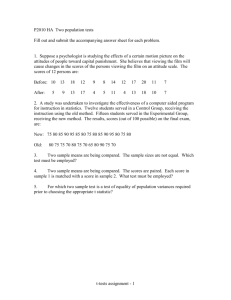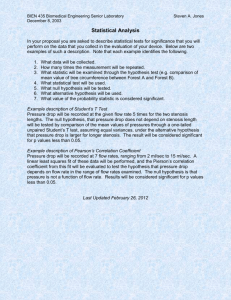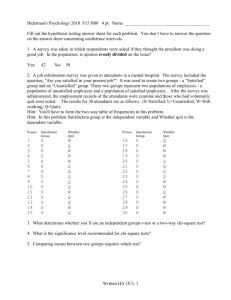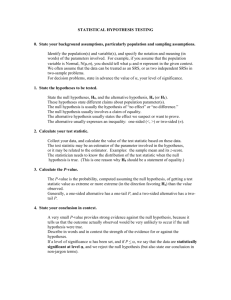Chapter 15 - Tests of Significance
advertisement
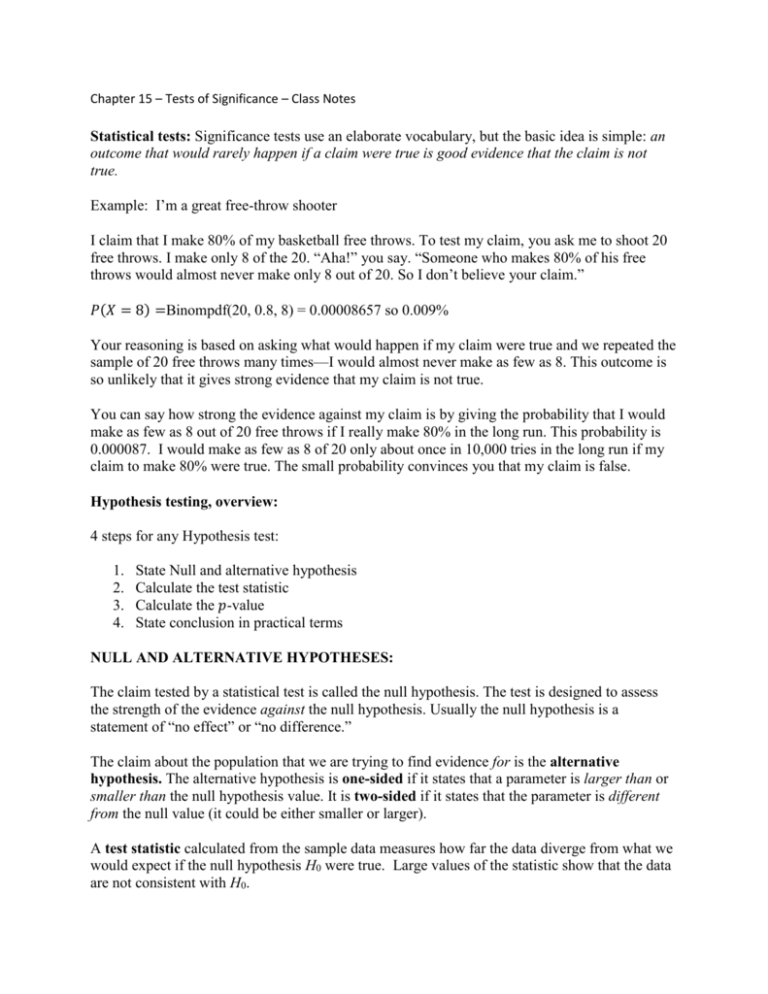
Chapter 15 – Tests of Significance – Class Notes Statistical tests: Significance tests use an elaborate vocabulary, but the basic idea is simple: an outcome that would rarely happen if a claim were true is good evidence that the claim is not true. Example: I’m a great free-throw shooter I claim that I make 80% of my basketball free throws. To test my claim, you ask me to shoot 20 free throws. I make only 8 of the 20. “Aha!” you say. “Someone who makes 80% of his free throws would almost never make only 8 out of 20. So I don’t believe your claim.” 𝑃(𝑋 = 8) =Binompdf(20, 0.8, 8) = 0.00008657 so 0.009% Your reasoning is based on asking what would happen if my claim were true and we repeated the sample of 20 free throws many times—I would almost never make as few as 8. This outcome is so unlikely that it gives strong evidence that my claim is not true. You can say how strong the evidence against my claim is by giving the probability that I would make as few as 8 out of 20 free throws if I really make 80% in the long run. This probability is 0.000087. I would make as few as 8 of 20 only about once in 10,000 tries in the long run if my claim to make 80% were true. The small probability convinces you that my claim is false. Hypothesis testing, overview: 4 steps for any Hypothesis test: 1. 2. 3. 4. State Null and alternative hypothesis Calculate the test statistic Calculate the 𝑝-value State conclusion in practical terms NULL AND ALTERNATIVE HYPOTHESES: The claim tested by a statistical test is called the null hypothesis. The test is designed to assess the strength of the evidence against the null hypothesis. Usually the null hypothesis is a statement of “no effect” or “no difference.” The claim about the population that we are trying to find evidence for is the alternative hypothesis. The alternative hypothesis is one-sided if it states that a parameter is larger than or smaller than the null hypothesis value. It is two-sided if it states that the parameter is different from the null value (it could be either smaller or larger). A test statistic calculated from the sample data measures how far the data diverge from what we would expect if the null hypothesis H0 were true. Large values of the statistic show that the data are not consistent with H0. The probability, computed assuming that H0 is true, that the test statistic would take a value as extreme or more extreme than that actually observed is called the P-value of the test. The smaller the P-value, the stronger the evidence against H0 provided by the data. If the P-value is as small as or smaller than a specified value a, the data are statistically significant at significance level α. First type of hypothesis test: 𝒛 TEST FOR A POPULATION MEAN Draw an SRS of size 𝑛 from a Normal population that has unknown mean µ and known standard deviation σ. To test the null hypothesis that µ has a specified value, 𝜇0 , 1) 𝐻0 : µ = µ0, where µ0 is a usually a number, called the hypothesized value 𝐻𝑎 : µ ≠ µ0 or µ >µ0 or µ < µ0 ̅−𝝁𝟎 𝒙 2) Calculate the one-sample z test statistic, 𝒛 = 𝝈/√𝒏 3) Calculate the 𝑃-value of the test, see below. 4) State conclusion (reject 𝐻0 , do not reject 𝐻0 ). In terms of a variable 𝑍 having the standard Normal distribution, the 𝑃-value for a test of 𝐻0 against 1. When can you use 𝒛 procedures for hypothesis tests on the mean? A. Population standard deviation must be known. B. If data follows a normal distribution or, if 𝒏 > 𝟑𝟎 and doesn’t have strong skewness or outliers 2. Practice stating 𝑯𝟎 and 𝑯𝒂 3. Find the 𝒑-value for a given 𝑯𝟎 and 𝑯𝒂 and test statistic. 4. Complete the 4 steps of a hypothesis test and state conclusion. Example: 𝑯𝟎 : 𝜇 = 5 𝑯𝒂 : 𝜇 > 5 a. If the test statistic, 𝒛 = 𝟏. 𝟐, find the p-value of the test. Solution: 𝑁𝑜𝑟𝑚𝑎𝑙𝑐𝑑𝑓(1.2, 1000, 0, 1) = 0.115 b. If the test statistic, 𝒛 = −𝟏. 𝟕𝟓, find the p-value of the test. Solution: 𝑁𝑜𝑟𝑚𝑎𝑙𝑐𝑑𝑓(−1000, −1.75, 0, 1) = 0.0406 𝑯𝟎 : 𝝁 = 𝟓 𝑯𝒂 : 𝝁 ≠ 𝟓 a. If the test statistic, 𝒛 = 𝟏. 𝟖, find the p-value of the test. b. If the test statistic, 𝒛 = −𝟏. 𝟖, find the p-value of the test The National Center for Health Statistics reports that the systolic blood pressure for males 35 to 44 years of age has mean 128 and standard deviation 15. The medical director of a large company looks at the medical records of 72 executives in this age group and finds that the mean systolic blood pressure in this sample is = 126.07. Is this evidence that the company’s executives have a different mean blood pressure from the general population? 𝐻0 : 𝐻𝑎 : Write these in practical terms Test statistic 𝑃-value: Conclusion: Note: Remember all these computations can be done using your calculator. Go to the TI Manual on the Stats Portal if you do not remember how to do this.



